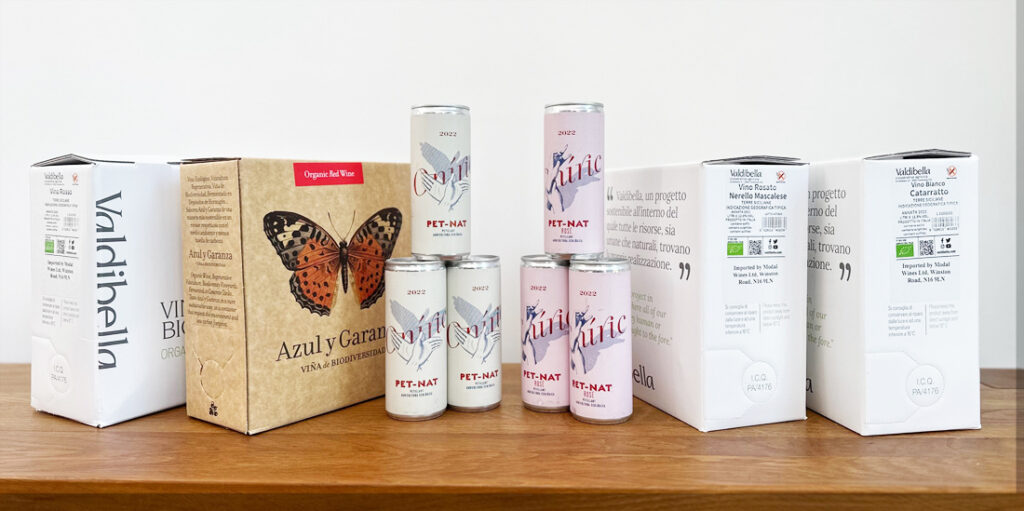Moving away from the traditional wine bottle to a more sustainable alternative.

“Wine should come in a glass bottle, right? Actually, wrong if wine drinkers want to do their bit for the planet’s resources and environment.” Jancis Robertson (OBE, ComMA, MW)
Drinking and serving wine is a practice steeped in tradition, from treading the grapes barefoot to popping the cork. As such, the quality of the wine and the drinking experience is heavily rooted in the perception of the bottle. The labels having an art movement of their own, in both the natural wine world filled with artists and designers. Or wine from more traditional winemakers where so much history and culture are held in the bottle and it’s the label.
It’s natural that when the wine comes without any of those aspects of ceremony and art, a stigma is attached to it. The idea that it’s an inferior product. We can see this clearly in the perception of wine with a screw-top. Where we jump to the conclusion that the liquid inside isn’t as high quality or made with the same environmental and sustainability considerations.
The wine bottle is the biggest environmental impact area of the wine industry. Generating large amounts of glass to be recycled and adding shipping weight to the transportation of the wine. Moving away from the glass bottle then has the potential to contribute to both financial savings and reductions to the carbon footprint of a glass of wine.
“Current estimates put the transportation of glass packaging at anywhere between 80% and 90% of the emissions costs of the wine industry”
What are the alternatives?
There are many alternatives to the glass bottle, including cans, bag in box or keg. And a growing body of importers who are innovating alongside winemakers to bring these to market. Who are utilising and exploring more sustainable methods of serving and celebrating their wine. Meaning that the bag-in-box wine, or maybe you know it as goon wine, is no longer reserved for house parties and festivals. It can be utilised to reduce waste and emissions associated with the drinks industry.
I spoke to Roman at Modal Wines who are importers of wine from independent winemakers with a genuine passion for their craft, regardless of location or style. Modal Wine showcase wine that is always made with the highest respect for nature; from the vineyards to the cellars. They were recently at the Vessel wine fair in London, where wine in alternative packaging was in the spotlight. We caught up about some of the benefits of, and response to, diversifying their portfolio into alternative packaging.
Why are you moving away from the traditional wine bottle?
We have felt for a long time that wine that is consumed in the year or so following its release does not need to come in glass packaging. Current estimates put the transportation of glass packaging at anywhere between 80% and 90% of the emissions costs of the wine industry. So it’s very clear that this is the area where we as an industry have the most room for improvement in terms of our environmental impact. We are finally reaching a point where consumers are shifting their views on packaging, and putting a higher value on environmental concerns, so the timing feels right to make a change.
Is there a price difference between the wines?
The actual liquid costs the same whether it goes in glass, box, can, or keg – it’s the same wine after all. Packaging costs vary, with some alternatives being less expensive and some working out around the same once all is said and done, but the main reason a consumer sees a price difference is because of lower shipping costs. Since more wine can fit in less space and add less weight to a shipping load in alternative packaging, you can get a higher quality wine at a lower price. It’s one of the few instances where lowering environmental costs actually lowers the price you pay!
How popular are your bag in box/alternatives?
We started with Bag in Box wines from our producer Valdibella a couple of years ago, and were frankly overwhelmed with the response. This made it clear to us that people were ready for higher quality wines in alternative formats, and set us on the road to grow the range and seek out other packaging alternatives. We have recently launched Pet Nat in cans (which actually finish their fermentation in can!) from Celler Entre Vinyes, and they have been off to a great start as well. We are just starting to receive our first wines in keykeg. As these are tried-and-true favourites from our range we are excited to see how they fare in their new format.
Ultimately, we are lucky to work with growers that produce delicious wines and customers who are open-minded to trying alternative formats, so we are optimistic that this is just the beginning of the journey.

How will you be serving wine at your next event?
